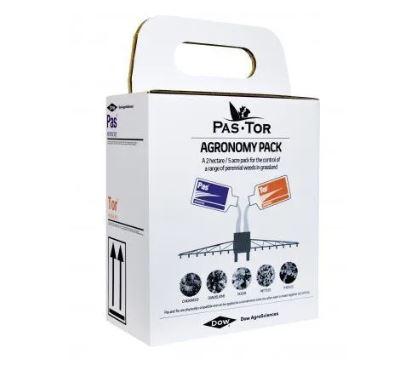
Description
Active Substances:
- Pas contains 150g/l Fluroxypyr and 15 g/l Triclopyr. MAPP No. 17772
- Tor contains 200g/l Clopyralid and 200g/l Triclopyr. MAPP No. 19958
Pas·Tor is a convenience tank mix containing the two systemic penetrant selective herbicides, Pas and Tor. Pas contains 150g/L Fluroxypyr and 150g/L Triclopyr while Tor contains 200g/l Clopyralid and 200g/l Triclopyr. Together they control docks, nettles and thistles in established grassland. Pas.Tor can be applied once per year at a rate of up to 2L/ha Pas and 1L/ha Tor
| Product Overview | |
|---|---|
| Product Type | Herbicide |
| Product Name | Pas·Tor |
| MAPP No. | 17772 & 19958 |
| Active Substances | Pas: 150g/l Fluroxypyr and 150g/l Triclopyr |
| Tor: 200g/l Clopyralid and 200g/l Triclopyr | |
| Formulation | Emulsifiable concentrate & Soluble concentrate |
| Areas of Use | Established grassland |
| Amateur/Professional | Professional |
| Phytomobility | Systemic penetrant |
| Mode of Action Group | Synthetic auxins |
Pas·Tor provides excellent long term control of difficult field weeds such as docks, thistles and nettles without impacting grass growth. The convenience tank mix contains the two systemic penetrant selective herbicides, Pas and Tor.
Instructions for use
Where to use:
- Grassland - Short and long-term grass leys and permanent pasture, which may be grazed and /or cut for subsequent animal consumption (Tor must not be used on grassland that will be grazed by horses and ponies).
When to use:
Apply between 1st March - 31st October when weeds are actively growing.
Thistles should be in the rosette stage and no bigger than 200mm across.
| Pas·Tor Application Window | |||||||||||
|---|---|---|---|---|---|---|---|---|---|---|---|
| Jan | Feb | Mar | Apr | May | Jun | Jul | Aug | Sep | Oct | Nov | Dec |
How to use:
- Apply at a rate of up to 2L/ha Pas and 1L/ha Tor in 200-400L/ha water. Best use advice is to use 1L/ha Pas + 1L/ha Tor for broad spectrum weed control covering an area of 2ha.
- Do not apply for 2-3 weeks following hay or silage cuts to allow sufficient regrowth to occur.
- Allow an interval of at least 21 days and ideally 28 days before cutting to allow maximum translocation.
| Crops | Maximum Treatments | Application Method | Application Rate | Water Volume | Spray Quality |
|---|---|---|---|---|---|
| Established grassland | 1 per year | Vehicle mounted hydraulic sprayer | 2 L/ha Pas 1 L/ha Tor |
300-400L/ha using flat fan nozzles | Medium |
Additional information:
- Do not spray in drought, very hot or very cold weather.
- Control may be reduced if rain falls within 2 hours.
- A further application in the following year may be required on large/well established weeds and where there is a lot of seed in the soil.
- Do not apply to grassland less than 1 year old.
- Do not roll or harrow grass for 10 days before or 7 days after application.
- Where susceptible crops are to be planted in the spring do not apply later than the end of July of the previous year.
- Do not use treated plant material for composting or mulching.
- Do not use manure from animals fed on treated crops for composting.
- Do not use on grassland that will be cut for animal feed, fodder or bedding.
- Avoid contact with non-target plants - clover will be killed or checked.
- Do not allow to contact water.
- Do not use on crops intended for seed production.
- Treated crops should not be re-entered before leaf surfaces have dried.
- Keep livestock out of the treated area for at least 7 days post application and DO NOT use on grassland which will be grazed by horses and ponies.
- Where ragwort is present, follow guidance for ragwort in the code of practice.
Active Substances
Clopyralid, Fluroxypyr and Triclopyr
Bio-Chemical Mode of Action: Clopyralid, Fluroxypyr and Triclopyr belong to the synthetic auxins group of herbicides.
Synthetic auxins work by inducing rapid abnormal cell growth and development in the stems, petioles and leaves of susceptible plants causing cell bursts and ultimately cell and plant death.
Mobility: Clopyralid, Fluroxypyr and Triclopyr are systemic penetrants which means that the active substance can be translocated downwards through the plant within the phloem (sugar conducting tissues) and upwards through the plant within the xylem (water conducting tissues).
Application timing: Systemic auxins are best applied when the weeds are actively growing. They are generally more effective when target plants are younger and in their vegetative phases.
Resistance: The incidences of resistance to synthetic auxins remains relatively low which is assumed to be because the herbicide has multiple sites of action.
However, resistance to synthetic auxins has been observed globally with 36 species being confirmed as resistant as of 2017. Best management practices, such as alternating with products with a different mode of action and using cultural weed control methods, will help to reduce the risk of further resistance.
For further information on Pas·Tor Combi Box, please contact a member of our technical sales team on 01952 897917.
Technical Information
| SKU | Product | File |
|---|---|---|
| 163140 | Pas·Tor Combi Box | Safety Data Sheet (PDF) |
| 163140 | Pas·Tor Combi Box | Product Label (PDF) |
| 163140 | Pas·Tor Combi Box | Technical Information Sheet (PDF) |
